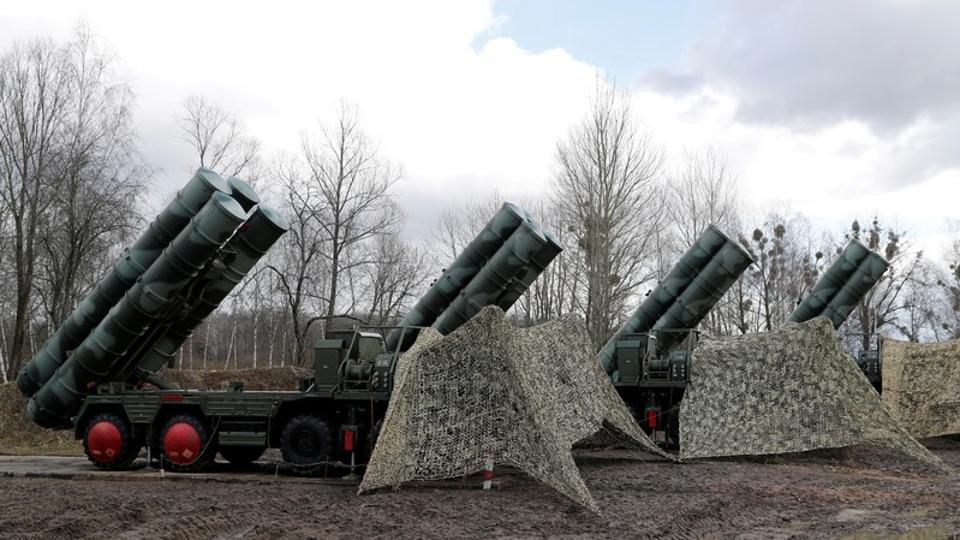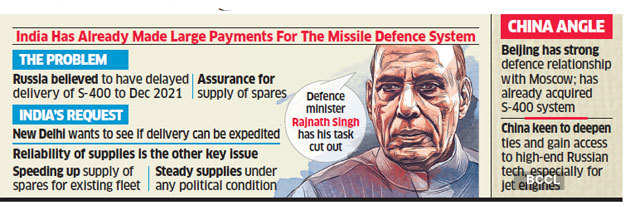WolfPack86
New Member
- Joined
- Oct 20, 2015
- Messages
- 10,571
- Likes
- 16,993

Loud Mouth USA Are caught by Balls From India‘Possibility of sanctions on India remain on table’, says top US diplomat
The possibility of US sanctions on India for buying the multi-billion dollar S-400 missile system from Russia remains on the table, a top American diplomat has said, asserting that New Delhi will have to make a strategic commitment to technologies and platforms.
In October 2018, India signed a USD 5 billion deal with Russia to buy five units of the S-400 air defence missile systems, notwithstanding warning from America that going ahead with the contract may invite US sanctions under the Countering America’s Adversaries Through Sanctions Act (CAATSA).
Last year, India made the first tranche of payment of around USD 800 million to Russia for the missile systems. The S-400 is known as Russia’s most advanced long-range surface-to-air missile defence system.
“CAATSA very much remains a policy priority, certainly for Congress, where you’ve seen the very strong demand for implementation and concern over the ability of Russia to gain monies from these military sales that will be used to further undermine the sovereignty of neighbouring countries,” Alice Wells, the outgoing Principal Deputy Assistant Secretary of State for South and Central Asian Affairs, told a Washington DC-based think tank on Wednesday.
The US had imposed sanctions on Russia under the stringent CAATSA. The law also provides for punitive action against countries purchasing defence hardware from Russia.
“CAATSA has not moved off the table. Instead of approaching it from a Russian prism though, I think the more important conversation to have is at this level of sophistication and as India is moving to adopt the highest level of technological systems, it really becomes a question of which system do they want to operate within,” Wells responded to a question posed by former US Ambassador to India Richard Verma.
“How do they want their systems to communicate with one another? It’s not a mix and match arrangement. At certain point, India will have to make sort of a strategic commitment to technologies and platforms and we think we have the best technologies and platforms,” Wells said while participating in a Atlantic Council-organised virtual discussion.
At the same time, the top US diplomat for South Asia who will retire on May 22 after a 31-year-long career, referred to the growing defense relationship between the two countries.
“We have also made strides in our defense trade, with the bilateral tally now crossing the 20 billion mark after the president’s visit. I think this administration deserves to take credit for making a concerted policy change to offer India our most advanced defense technologies such as armed Unmanned Aerial Vehicle,” she said.
“It’s quite remarkable to think that the same missile defense system protecting Washington DC will soon be protecting new Delhi,” Wells said.
India’s growing capabilities as a first responder have also been on display in the Indian ocean where it has been delivering COVID relief, often using US-origin platforms to dozens of countries.
“Looking ahead, I’m confident that defense trade and interoperability will continue to grow even though COVID-19 related budgetary challenges may slow the pace,” she noted.
“One area where I think we can exert even more attention is preparing for 21st century threats, especially as the military implications of artificial intelligence, autonomous devices and quantum computing become more pronounced. I’m proud that our maturing relationship has allowed us to develop a new degree of resiliency and self-confidence and that does allow us to navigate differences on issues like trade sanctions and visas,” she said.
Wells also said the US sees India as a global power and understands the country’s global interests which it seeks to protect diplomatically, politically, economically, and militarily.
The US and India share a vision for an Indo-Pacific order that respects sovereignty and rule of law.
“India seeks to become, you know, in the words of (External Affairs) Minister Jaishankar a leading power, but one that plays by the rules. We in turn recognise that India is successful, (its) rise contributes to an environment in Asia that serves US interests,” she said.
“So, this strategic meeting of the minds on the Indo-Pacific vision has greatly enhanced how we’re able to work together, around the world. As saw in what was rebranded as the comprehensive global strategic partnership announced earlier this year during President Trump’s historic visit to India,” Wells said.
Jaishankar told US Secretary of State Mike Pompeo in June last year that India will go by its national interest while dealing with other countries, including with sanctions-hit Russia from whom New Delhi is procuring S-400 missile defence systems.
The personal rapport between President Trump and Prime Minister Narendra Modi is clear and it has clearly helped the relationship, she said.
“Another example is the QUAD, which is well on its way to becoming one of the premier forums of the Indio-Pacific. In just the past year, we held the inaugural QUAD ministerial meeting. We saw QUAD ambassadors meeting regularly in countries across the Pacific and we convened experts meetings on counter terrorism, cyber issues, and maritime security,” she said.
The QUAD is also playing a role in their COVID-19 coordination, Wells said.
QUAD is an informal strategic dialogue between the US, Japan, Australia and India that is maintained by talks between member countries.

‘Possibility of sanctions on India remain on table’, says top US diplomat
India signed a $5 billion deal with Russia to buy five units of S-400 air defence missile systems, notwithstanding warning from US that going ahead with the contract may invite sanctions under CAATSA.www.hindustantimes.com
this is probably fake news?? I think this issue has been settled long back.Loud Mouth USA Are caught by Balls From India
Even turkey didn't a Shit
USA Bad cop policy is boring
Trp mogering Pro chinese lobby Media misquoted itthis is probably fake news?? I think this issue has been settled long back.



This buy was prior to CAATSA it maybe hinting any new buys?? NATO member TurkeyTrp mogering Pro chinese lobby Media misquoted it
this what She said CAATSA very much remains a policy priority, certainly for Congress, where you’ve seen the very strong demand for implementation and concern over the ability of Russia to gain monies from these military sales that will be used to further undermine the sovereignty of neighbouring countries,” Alice Wells, the outgoing Principal Deputy Assistant Secretary of State for South and Central Asian Affairs, told a Washington DC-based think tank on Wednesday.
What is Generalized by LW's dallal media
Possibility of sanctions on India remain on table’, says top US diplomat




She Is a Neutral She Is more Aligned With US interestThis buy was prior to CAATSA it maybe hinting any new buys?? NATO member Turkey
no backlash?? Alice Wells is pro -pakistan :
Waive debt or renegotiate loans to create a fair deal for Pak: US to China

Waive debt or renegotiate loans to create a fair deal for Pak: US to China
It is really incumbent on China to take steps to alleviate the burden this predatory, unsustainable and unfair lending is going to cause to Pakistan, Alice Wells sayswww.business-standard.com


| India’s S-400 Triumf air defence system is currently in production in Russia and will undergo a series of trials before its arrival in the country by the end of 2021. Sources said amid tensions with China at the Line of Actual Control in Ladakh, Russia will supply certain kinds of missiles and bombs for the Indian Air Force and the Army as part of emergency procurement. Sources also said during the recent visit of Defence Minister Rajnath Singh to Russia, a review of all defence contracts signed and those in pipeline was done. Diplomatic sources said India has sought emergency delivery of quite a few items. They said India is aware that according to the contract, the delivery of the S-400 system would begin within 24 months from the payment of the first tranche of the $5.2-billion dollar deal. Sources said even though the contract for the system, which will be India’s air defence umbrella and the main pillar of the Indian Air Force’s defence grid, was signed in October 2018, the payment took time because both countries had to find a way around the US sanctions against Russia. Initially, it was expected that the first of the five S-400 systems will start coming in by the end of 2020. Following this, the rest of the four systems will be supplied over a period of four years. “The production process involves a lot of computing and coding, which is very specific to the requirements of a particular customer. There are series of tests that are conducted, which are also followed up by training. The production can’t be simply sped up,” a source said. The source added it is not like in-use missiles, which can be diverted from Russian forces to India or any other customer. Capabilities of S-400 The S-400 is the most modern air defence system in the Russian arsenal meant for export. It is capable of destroying incoming hostile aircraft, missiles and even drones within a range of up to 400 km. It has a tracking capability of nearly 600 km. The system has been designed to knock down flying targets, including those equipped with stealth technologies, at a distance of about 400 km. It is also capable of taking out ballistic missiles and hypersonic targets. Compared to its predecessor — the S-300 — the S-400 has a firing rate that is 2.5 times faster. As reported by ThePrint earlier, each S-400 battery comprises long-range radar, a command post vehicle, target acquisition radar and two battalions of launchers (each battalion has eight). Each launcher has four tubes. The S-400 can be armed with four different types of missiles with ranges of 400 km, 250 km, 120 km and 40 km. The long-range radar can track more than 100 flying objects simultaneously while being able to engage a dozen targets. |
A stealth fighter would always be vulnerable against low frequency GBR. The stealth works great against high frequency radars which is used for targeting purpose.Then ....if a stealth fighter can be caught with radar....then why to spend on costly fighter s . Better use spj pod on fighter s
Stealth doesn't make invisible, it just makes the aircraft difficult to detect and track (specifically tack).Then ....if a stealth fighter can be caught with radar....then why to spend on costly fighter s . Better use spj pod on fighter s
I've heard this arguments a lot of time but don't know how accurate they are.A stealth fighter would always be vulnerable against low frequency GBR. The stealth works great against high frequency radars which is used for targeting purpose.
